
The American Locomotive Company was an American manufacturer that operated from 1901 to 1969, initially specializing in the production of locomotives but later diversifying and fabricating at various times diesel generators, automobiles, steel, tanks, munitions, oil-production equipment, as well as heat exchangers for nuclear power plants.

GE Transportation is a division of Wabtec. It was known as GE Rail and owned by General Electric until sold to Wabtec on February 25, 2019. The organization manufactures equipment for the railroad, marine, mining, drilling and energy generation industries. The company was founded in 1907. It is headquartered in Pittsburgh, Pennsylvania, while its main manufacturing facility is located in Erie, Pennsylvania. Locomotives are assembled at the Erie plant, while engine manufacturing takes place in Grove City, Pennsylvania. In May 2011, the company announced plans to build a second locomotive factory in Fort Worth, Texas, which opened in January 2013.

Montreal Locomotive Works (MLW) was a Canadian railway locomotive manufacturer that existed under several names from 1883 to 1985, producing both steam and diesel locomotives. For many years it was a subsidiary of the American Locomotive Company. MLW's headquarters and manufacturing facilities were in Montreal, Quebec.

The EMD GP30 is a 2,250 hp (1,680 kW) four-axle diesel-electric locomotive built by General Motors Electro-Motive Division of La Grange, Illinois between July 1961 and November 1963. A total of 948 units were built for railroads in the United States and Canada, including 40 cabless B units for the Union Pacific Railroad.

The Canadian Locomotive Company, commonly referred to as CLC, was a Canadian manufacturer of railway locomotives located in Kingston, Ontario. Its works were located on the south side of Ontario Street between William and Gore streets on Kingston's waterfront.

The EMD F7 is a model of 1,500-horsepower (1,100 kW) diesel-electric locomotive produced between February 1949 and December 1953 by the Electro-Motive Division of General Motors (EMD) and General Motors Diesel (GMD).

The EMD F9 is a 1,750 horsepower (1,300 kW) Diesel-electric locomotive produced between February 1953 and May 1960 by the Electro-Motive Division of General Motors (EMD) and General Motors Diesel (GMD). It succeeded the F7 model in GM-EMD's F-unit sequence. Final assembly was at GM-EMD's La Grange, Illinois plant. The F9 was also built in Canada by General Motors Diesel at their London, Ontario plant. A total of 101 cab-equipped lead A units and 156 cabless booster B units were built. The F9 was the fifth model in GM-EMD's highly successful "F" series of cab unit diesel locomotives.

The EMD FP7 is a 1,500 horsepower (1,100 kW), B-B dual-service passenger and freight-hauling diesel locomotive produced between June 1949 and December 1953 by General Motors' Electro-Motive Division and General Motors Diesel. Final assembly was at GM-EMD's La Grange, Illinois plant, excepting locomotives destined for Canada, in which case final assembly was at GMD's plant in London, Ontario. The FP7 was essentially EMD's F7A locomotive extended by four feet to give greater water capacity for the steam generator for heating passenger trains.

The EMD FP9 is an American 1,750 horsepower (1,300 kW), B-B dual-service passenger and freight-hauling diesel locomotive that was produced between February 1954 and December 1959 by General Motors Electro-Motive Division, and General Motors Diesel. Final assembly was at GM-EMD's La Grange, Illinois plant, except for Canadian orders, which were assembled by Canadian subsidiary GMD at London, Ontario. The FP9 was essentially EMD's F9 locomotive extended by 4 feet (1.2 m) to give greater steam generator and water capacity for hauling passenger trains. A total of 90 cab-equipped lead A units were built; unlike the freight series, no cabless booster B units were sold. Regular F9B units were sometimes used with FP9 A units, since they, lacking cabs, had more room for water and steam generators. The FP9 and its predecessor, the FP7, were offshoots of GM-EMD's highly successful F-unit series of cab unit diesel locomotives.

Electro-Motive Diesel is a brand of diesel-electric locomotives, locomotive products and diesel engines for the rail industry. Formerly a division of General Motors, EMD is now owned by Progress Rail, a subsidiary of Caterpillar Inc. Electro-Motive Diesel traces its roots to the Electro-Motive Engineering Corporation, founded in 1922 and purchased by General Motors in 1930. After purchase by GM, the company was known as GM's Electro-Motive Division. In 2005, GM sold EMD to Greenbriar Equity Group and Berkshire Partners, and in 2010, EMD was sold to Progress Rail. Upon the 2005 sale, the company was renamed to Electro-Motive Diesel.

The EMD SW900 is a diesel switcher locomotive built by General Motors Electro-Motive Division and General Motors Diesel (GMD) between December 1953 and March 1969. Power was provided by an EMD 567C 8-cylinder engine that generated 900 horsepower (670 kW). Built concurrently with the SW1200, the eight-cylinder units had a single exhaust stack. The last two SW900s built by GMD for British Columbia Hydro were built with 8 cylinder 645E engines rated at 1,000 horsepower (750 kW).

The EMD GP7 is a four-axle (B-B) diesel-electric locomotive built by General Motors Electro-Motive Division and General Motors Diesel between October 1949 and May 1954.

The EMD GP9 is a four-axle diesel-electric locomotive built by General Motors' Electro-Motive Division between 1954 and 1959. The GP9 succeeded the GP7 as the second model of EMD's General Purpose (GP) line, incorporating a new sixteen-cylinder engine which generated 1,750 horsepower (1.30 MW). This locomotive type was offered both with and without control cabs; locomotives built without control cabs were called GP9B locomotives.

The EMD GP38-2 is an American four-axle diesel-electric locomotive built by General Motors, Electro-Motive Division. Part of the EMD Dash 2 line, the GP38-2 was an upgraded version of the earlier GP38. Power is provided by an EMD 645E 16-cylinder engine, which generates 2,000 horsepower.

The EMD GP35 is a 4-axle diesel-electric locomotive built by General Motors Electro-Motive Division between July 1963 and December 1965 and by General Motors Diesel between May 1964 and January 1966. 1251 examples were built for American railroads, 26 were built for Canadian railroads and 57 were built for Mexican railroads. Power was provided by a turbocharged EMD 567D3A 16-cylinder engine which generated 2,500 horsepower (1,860 kW).

The EMD SD40 is an American 6-axle diesel-electric locomotive built by General Motors Electro-Motive Division between January 1966 and August 1972. 1,268 locomotives were built between 1966 and 1972. In 1972, an improved version with new electronics was developed and marketed as a new locomotive, the SD40-2.

An SDP40 is a 6-axle passenger diesel-electric locomotive built by General Motors Electro-Motive Division (EMD) between June 1966 and May 1970.

The GMD GMD1 is a diesel locomotive originally produced by General Motors Diesel (GMD), the Canadian subsidiary of General Motors Electro-Motive Division, between August 1958 and April 1960. This road switcher locomotive is powered by a 12-cylinder EMD 567C diesel engine, capable of producing 1,200 horsepower (890 kW). The GMD1 was built on either Flexicoil A1A-A1A or Flexicoil B-B trucks. One hundred and one were built, Canadian National (CN) purchased 96 and Northern Alberta Railways (NAR) the remaining five, which later became part of CN's fleet when they acquired majority interest in NAR.

The ALCO FA was a family of B-B diesel locomotives designed to haul freight trains. The locomotives were built by a partnership of ALCO and General Electric in Schenectady, New York, between January 1946 and May 1959. Designed by General Electric's Ray Patten, they were of a cab unit design; both cab-equipped lead FA and cabless booster FB models were built. A dual passenger-freight version, the FPA/FPB, was also offered. It was equipped with a steam generator for heating passenger cars.
Stadler Rail Valencia SAU is a Spanish company, mainly producing products for the railway industry, subsidiary of Stadler Rail.





















